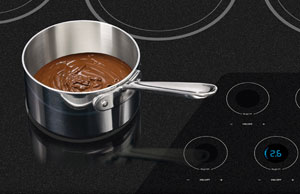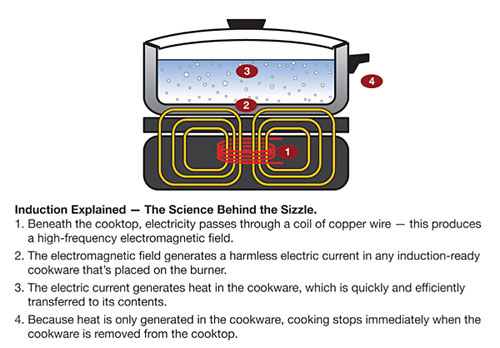New major appliance design is transforming energy usage and delivering a remarkable choice of features that support the lifestyles of today's consumers.
COOKING APPLIANCES
Gone are the days when women expertly scheduled meal preparation around the single stove whose ill-lit and unevenly heated oven cooked three dishes at once at best. New cooking methods and intelligent controls in today's kitchens allow cooks to focus on the food rather than logistics and treat cooking as a creative and sometimes social act instead of work.
Cooktops
Cooktops installed within islands help make the kitchen the focal point of the home, especially when family members and guests sit across the counter from the cook.
Induction. The most significant technology for surface cookers to come on the market in the past decade is the induction element (see Induction Cooking sidebar.) Typical models come with up to five elements housed within a sealed smooth top glass surface. An LED display with up to ten settings can immediately raise or lower temperatures, maintain food at the perfect serving temperatures and activate an easy-to-read kitchen timer.
 |
|
Photo: Electrolux Home Products, Inc. |
Hybrid induction/electric. For those who want the option of using the conventional electric cooktop, hybrid cooktops with, for example, two induction elements and one or two electric elements are available. Innovations include:
• Expandable induction and electric elements. Some models are equipped with 7-in to 11-in expandable induction elements to accommodate different sized cookware while maintaining energy efficiency. A 6-in burner size provides 1,500 watts; a 7-in provides 1,900 watts; an 8-in provides 2,300 to 3,200 watts; an expandable 7-in to 11-in provides up to 3,400 watts for large pots and pans.
• Cook-surface sensors that automatically detect the presence of induction-ready cookware activate the induction field, and direct heat to the exact diameter of the pot or pan.
Gas. While employing traditional heating mechanisms, gas cooktops have more precisely managed control knobs, dishwasher-safe continuous grates for easily moving pans and at least one dual flame burner that ranges from 450 BTU to 18,000 BTU. Hybrid, gas and electric cooktops are typically ADA compliant.Â
The Science Behind Induction Cooking |
Induction Cooking
Now recognized by Consumer Reports as a mainstream cooking system, induction is completely different from all other cooking technologies. Induction cooking is chiefly distinguished by the fact that the heat is generated directly in the cooking vessel, as opposed to being generated in the range top by electric radiants or burning gas and then transferred to the cooking vessel. An induction element or "burner" is a powerful, high frequency electromagnet, with the electromagnetism generated by sophisticated electronics in the "element" under the unit's ceramic surface. When a good-sized piece of magnetic material - such as, for example, a cast-iron skillet - is placed in the magnetic field that the element is generating, the field transfers ("induces") energy into that metal. The transferred energy causes the metal - the cooking vessel - to become hot. The amount of heat being generated in the cooking vessel is controlled by the strength of the electromagnetic field, which can be changed instantaneously.
Benefits. This form of flameless cooking has certain advantages over conventional gas flame and electric cookers:
- More energy efficient. The DOE reports that the efficiency of energy transfer for an induction cooktop is 84 percent compared with 71.5 percent for electric and 40 percent for gas.
- No wait for preheating. An induction element starts cooking right away.
- Improved thermal efficiency, and greater heat consistency, yet the same or greater degree of precise control as gas. The amount of time that it takes a pot of water to boil depends on the power. That time can be from three minutes for 3600-watt induction elements to around ten minutes for 1200-watt ones.
- Safer in situations in which a hotplate would typically be dangerous or illegal, an induction plate is ideal, as it creates no heat itself. There are no open flames and the "element" itself reaches only the temperature of the cooking vessel; only the pan generates heat.
- Easier to clean because the cooking surface is flat, smooth and stays cool, even though it may have several zones of induction heating. In addition, food tends not to burn onto the cooking surface since it is nowhere near as hot as the pot and contents.
- A built-in induction range is now on the market.
Drawbacks
- Cookware used on it must be made of ferrous materials.Induction cookers do not work at all with non-conducting cookware such as glass or ceramic. Nor will copper or aluminum pans heat up on a typical induction cooker. Cast-iron cookware, including ceramic- or porcelain-coated cast iron, is suitable, as is most stainless steel or clad cookware containing stainless steel.
- Curved-bottom pans, such as woks do not do well except on a correspondingly curved induction unit designed expressly for woks.
- Possibly hazardous for persons with a pacemaker or defibrillator. Users are advised to make their own evaluation and seek the opinion of their cardiologists. There are a number of studies on the subject. For example: "Induction Ovens and Electromagnetic Interference: What is the Risk for Patients with Implantable Cardioverter Defibrillators?" by Christian Binggeli, et al. inJournal of Cardiovascular Electrophysiology, concluded that ICD (implantable cardioverter defibrillator) patients can be reassured that electromagnetic interference (EMI) is unlikely to affect their devices if induction ovens are used in their kitchens. Another study titled, "Do induction cooktops interfere with cardiac pacemakers?" by Werner Irnich and Alan D. Bernstein, which appeared in Europace 2006, concluded that patients are at risk if the implant is unipolar and left-sided, if they stand as close as possible to the induction cooktop, and if the pot is not concentric with the induction coil.
- More expensivethan other electric and gas cooktops.
- Requires careful installation, because the electronics within an induction cooktop need to vent significant amounts of heat during operation. Owing to heat-venting requirements, not all induction cooktops can safely be installed over wall ovens. Design professionals should therefore consult the manufacturer's installation instructions to determine which combinations are considered acceptable.
|
 |
| Source: Induction Cooking World |











